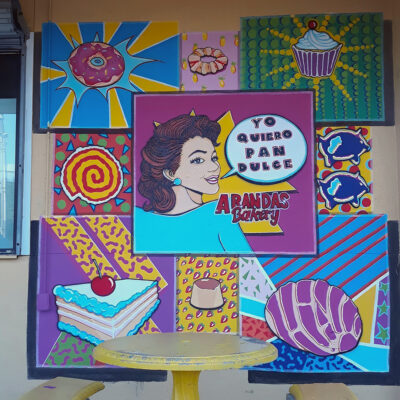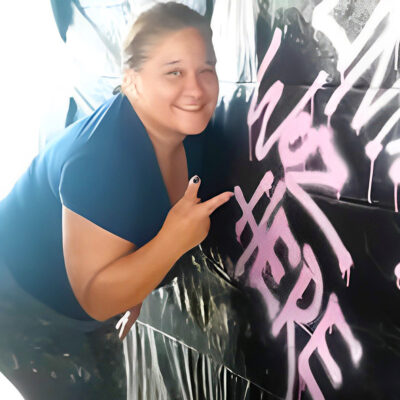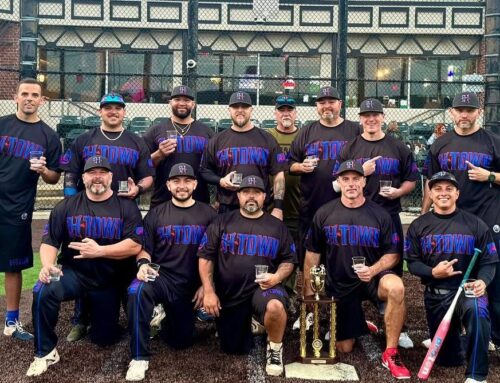 Linda Hinojos remembers her excitement upon arriving at Hobby Airport at age five with her family. The bustling cars, street sounds, and planes soaring overhead contrasted sharply with the serene mesas and rocky outcrops of her rural hometown, Las Cruces, New Mexico.
Linda Hinojos remembers her excitement upon arriving at Hobby Airport at age five with her family. The bustling cars, street sounds, and planes soaring overhead contrasted sharply with the serene mesas and rocky outcrops of her rural hometown, Las Cruces, New Mexico.
The big city, with a new home just a stone’s throw away from a major airport, energized her family, offering them the promise of new opportunities, she recalled. Little did she know that this experience would be the start of her discovering a calling to bring art and transformation to her beloved community.
Four decades later, Hinojos, an airbrush artist and public art advocate, is setting in motion her initiative, “Paint My Community,” to push for the creation of a Houston-Hobby Art District that provides artistic training, exposure, and opportunities for local artists while enriching the community with public art.
It would provide resources she lacked as a child.
“I never had the opportunity to be inspired by or appreciate public art in my Houston Hobby community,” she said.
Early on, the airport did entice Hinojos to become a pilot. She enrolled in an aviation magnet program in high school.
But exposure to art, at her first job at the former Six Flags AstroWorld’s airbrush shop in 1992, would soon ignite her calling to art as a career while fostering an entrepreneurial spirit in her.
 Her art and community engagement projects over the years have run from teaching after-school art classes on a volunteer basis to directing an art gallery and scouting for friendly venues to create public artwork. She also became the creative director for the League of United Latin American Citizens Council 2911, using art to address social issues.
Her art and community engagement projects over the years have run from teaching after-school art classes on a volunteer basis to directing an art gallery and scouting for friendly venues to create public artwork. She also became the creative director for the League of United Latin American Citizens Council 2911, using art to address social issues.
Hinojos’ artistic pursuits also took her on diverse learning paths. She studied architectural drawing in a Harvard Graduate School of Design summer program. Hinojos received an associate’s degree in digital communication from Houston Community College. She earned a bachelor’s degree in art from Texas Southern University.
Through it all, Hinojos has witnessed what she considers to be a woeful lack of resources and artistic expression in Hobby area neighborhoods — while appreciating the transformative power of art among children and adults.
“I saw the kids I taught in my community missing out on art experiences just like I did,” Hinojos said. “When I looked around and saw other communities with art in public spaces and cultural activities, I asked, ‘Why not here?’
“I deeply believe that art should be accessible to everyone, but it’s evident the Hobby community is underserved. I see a lack of creative resources and public art installations, limited opportunities for local artists, insufficient education for students, and a lack of technological innovation in art. I have a responsibility to step up.”
She envisions the Houston-Hobby Art District as a vibrant hub of artistic expression and a tourist destination, showcasing the city’s art and culture through murals, sculptures, recycled art, mosaics, wraps, and digital art.
 Moreover, it would provide hands-on training and employment opportunities for local art students; host art festivals, workshops, and educational programs with involvement from residents, schools, and organizations; and serve as a platform for public advocacy, with commissioned artworks shedding light on social issues and celebrating the diversity of the neighborhood.
Moreover, it would provide hands-on training and employment opportunities for local art students; host art festivals, workshops, and educational programs with involvement from residents, schools, and organizations; and serve as a platform for public advocacy, with commissioned artworks shedding light on social issues and celebrating the diversity of the neighborhood.
The proposed art district might qualify as a cultural district under the Texas Commission on the Arts as authorized by the Texas Legislature in 2005. The state recognizes such districts as a means to foster cultural expressions, generate businesses, attract tourists, and stimulate economic and cultural development for community revitalization.
Various funding methods can be explored to support cultural districts, including government grants, private donations, tax increment financing, sponsorships and partnerships, membership programs, and visitor lodging taxes.
Along with local artists and art advocates, Hinojos has set a comprehensive timeline for the district’s creation, including fundraising, neighborhood clean-ups, community engagement programs, creating and installing artworks on commercial buildings, and seeking collaboration with art majors at local colleges.
“Funding is pivotal to our efforts, but has been a challenge,” she said. Her team plans to reach out to businesses, community leaders, and government entities for financial backing.
“But we are pushing forward no matter what. People will support us once our artworks take shape and people see them.”
Contact Hinojos by e-mail at [email protected]
— by Zen Zheng





